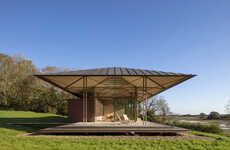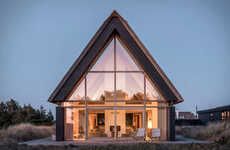
Sluice Point House is Based on Acadian Salt Hay Stacks
Joey Haar — October 18, 2017 — Art & Design
References: archdaily
Despite the technological rigors of modern architecture, there are still things that can be gleaned from the buildings of the past, and that's exactly what Sluice Point House does. The seasonal cottage is inspired by the historic Acadian salt hay stacks that were built in the surrounding marshes of Yarmouth Point thousands of years ago.
When the Acadians settled in Nova Scotia, they immediately took to the rich saltwater marshes of the area. The landscape was full of abundant grasses that their cattle could feed on while the harvests grew and were reaped, making it easier to farm livestock. The issue came with storing hay for cattle, which would be rendered useless after being frozen in the marshes over the winter. The Acadians thus built platforms called salt hay stacks that they used to keep the hay dry through winter, and these stacks inspired the design of Sluice Point House.
When the Acadians settled in Nova Scotia, they immediately took to the rich saltwater marshes of the area. The landscape was full of abundant grasses that their cattle could feed on while the harvests grew and were reaped, making it easier to farm livestock. The issue came with storing hay for cattle, which would be rendered useless after being frozen in the marshes over the winter. The Acadians thus built platforms called salt hay stacks that they used to keep the hay dry through winter, and these stacks inspired the design of Sluice Point House.
Trend Themes
1. Historic Architecture - Using traditional building methods to inspire modern designs.
2. Sustainable Design - Incorporating the environment into the design to create a harmonious structure.
3. Cultural Preservation - Preserving the history and cultural practices through architecture.
Industry Implications
1. Architecture - Opportunities for architects to creatively interpret and incorporate traditional building practices into modern designs.
2. Tourism - Creating small-scale themed accommodations that reflect local history and culture for tourists to experience.
3. Sustainable Agriculture - Exploring sustainable livestock management practices through the implementation of traditional hay stacking methods.
4.3
Score
Popularity
Activity
Freshness























